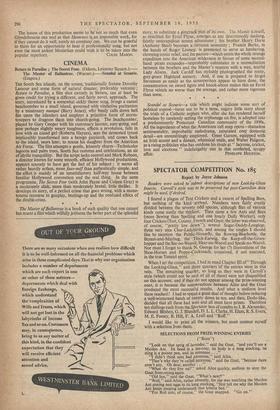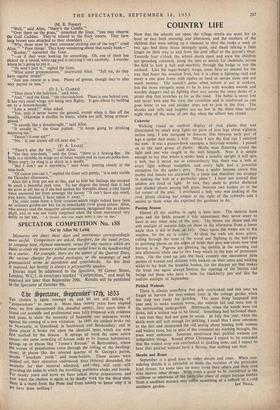SPECTATOR COMPETITION No. iSs
Report by Joyce Johnson Readers were asked to' submit descriptions of new Looking-Glass Insects. Carroll's style was to be preserved but post-Carroilian data might be used, if desired.
I feared a plague of Test Crickets and a swarm of Spelling Bees, but nothing of the kind arrived. Numbers were fairly evenly divided between the seventy odd species, although flies of various kinds came easily the thickest. Then came a few Ants and Bees (more Sewing than Spelling and one lonely Daily Worker), only four Crickets (Test, County, French and Gnot; the latter was observed, of course, ".pretty low down"), several Sugar-Daddy-Longlegs, three very nice Char-Ladybirds, and among the singles I should like to mention the Public-Housefly, the Rowing-Bluebottle, the Bryant-and-Maybug, the Thick-Earwig, the Keep-off-the-Grass- hopper and the See-no-Weevil, Hear-no-Weevil and Speak-no-Weevil. Nor must I forget to thank N. George for her (?) illustrations of the Shoe-Hornet and Poppy-Cockroach, conceived, if not executed, in the true Tenniel spirit.
When I set the competition, I had in mind Chapter III of "Through the Looking-Glass," and three quarters bf the entries were in this vein. The remaining quarter, so long as they were in Carroll's style (which could not be said of all of them) were not disqualified on this account, and if they do not appear among the prize-winning ones, it is because the conversations between Alice and the Gnat produced the most successful results. And what a uniform level these reached ! I had to spend a great deal of thought before reducing a well-winnowed batch of twenty down to ten, and then, Dodo-like, decided that all these had won and all must have prizes. Therefore ten shillings each from the Spectator box of comfits to J. B. Alexander, Edward Blishen, G. J. Blundell, D. L. L. Clarke, H. Elam, R. S. Evers, M. E. Fossey, B. Hill, F. A. Lyall and "Roff."
I would like to print all the winners, but must content myself with a selection from them.
SELECTIONS FROM PRIZE-WINNING ENTRIES ("RoFp") "Look on that sprig of lavender," said the Gnat, "and you'll see a Maiden Ant. Its head is a tea-cosy, its body is a long stocking, its sting is a poison pen, and its antennae . . ." "I didn't think ants had antennae," said Alice.
"That's why they're called antennae," said the Gnat, "because there aren't any. Oh dear, another .. •"
"What do they live on?" asked Alice quickly, anxious to stop the Gnat from.crying again.
"Old lice, said the Gnat, "What's next?" "Well," said Alice, rather absently, for she was watching the Maiden Ant storing nest eggs in its long stocking, "first tell me why the Maiden
Ant keeps peeping underneath that lobelia bed." • "For Red ants, of course," the Gnat snapped. "Go on."
(M. E. Fosssv)
"Well," said Alice, "there's the Caddis."
"Over there on the grass," remarked the Gnat, "you may observe the Golf Caddies. They're related to the Stick insects. They have long brown sacs attached to their shoulders . . ."
"Why, those must be their antennae sticking out of the top!" cried Alice." " Poor things! They keep wandering about that sandy bank—" "Bunker," corrected the Gnat.
"—as if they were looking for something. Oh, one of them has picked up a round, white egg and is carrying it very carefully. I wonder where he's going to put it ..."
"He won't putt it," sighed the Gnat.
"What queer pronunciation," murmured Alice. "Tell me, do they have regular meals?"
"Just one course at a time. Plenty of greens; though they're also very partial to tees."
(D. L. L. CLARKE)
"Then there's the ladybird," said Alice. "And," said the Gnat, "the char-ladybird. There is one behind you.
It has very small wings, not being very flighty. It gets about by holding on to a broom-handle."
"Like a witch?" Alice asked.
"Yes, only it never leaves the ground, except when it flies off the handle. Otherwise it shuffles its knees, which are stiff, being armour- plated."
"It sounds like a dreadnought," said Alice.
"It usually is," the Gnat replied. "It keeps going by drinking steaming tea.
"Doesn't it ever eat?"
"No. It just crawls off till.next day."
(F. A. LYALL) I "There's also the bee," said Alice.
IF "On that rose-bush," said the Gnat, "there is a Sewing-Bee. Its body is a thimble, its wings are of finest muslin and its eyes are polka dots. When angry, its sting is as sharp as a needle." "But I don't see it anywhere," said Alice, peering closely at the rose-bush.
"Of course you can't," replied the Gnat very gently, "it is only visible on Thursday afternoons." Alice felt a little put out at this, and to hide her feelings she stooped to smell a beautiful pink rose. To her disgust she found that it had no scent at all; but as if she had spoken her thoughts aloud, a tiny liquid voice answered her from amongst the leaves: "It can't have any smell, you know, because I have taken it away."
The voice came from a little creature which might indeed have been an ordinary garden ant but for its remarkably vivid green colour. Alice, who always read the magazine advertisements, recognised this as chloro- phyll, and so was not really surprised when the Gnat murmured very softly in her ear, Deodor Ant—you might make a joke on that."



































 Previous page
Previous page